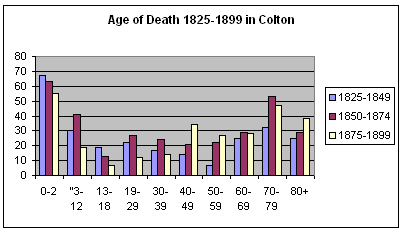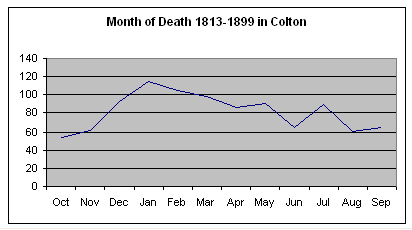There is very little information available about sickness and health in Colton before 1837. What is available can only be gleaned from looking at parish registers and notes written by the Rectors.
After 1837 the information can be obtained by looking at the death registers and this has given us some insight into life expectancy from that time until the dawn of the 20th Century.
Medieval to Early Modern Times
Medieval (pre 1500)
Very little evidence relating to this period has survived and no parish records exist. During this time people had very little understanding about what caused disease and blamed it on the planets and unbalanced humours in the body.
The main three causes of death were from disease, accidents and childbirth.
Disease was often caused by poor sanitation, damp and cold living conditions, poor storage of food and infestations, often from the thatched roofs.
Early Modern (1500-1760)
Life expectancy in England was about 32-40yrs, although if people survived past adolescence and childbirth they could live well into old age. Infant mortality was at its peak in the early 1700’s, although rural areas like Colton, had lower infant mortality. One of the biggest killers at this time was Bubonic plague, there is no evidence to suggest that it came to Colton and the parish registers, which commenced in 1647, do not show any increase in deaths during the time of the plague. Remedies during this time were mainly herbal.
Extracts from Colton Parish records and Poor relief
The parish records start from 1647 and were written in Latin, some of the early records are illegible and damaged
1652 October 14” Thomas son of Thomas Lees baptised, same day wife of Thomas Lees buried” it is probable that Thomas Lees wife died in childbirth (extract from the parish records).
In 1726 “Widow Short given 1s while ill” (extract from the poor relief records.)
Victorian Health
By the mid 1800’s the life expectancy in cities averaged between 25 and 30 years, but in rural areas like Colton it was higher at 41 years. The influencing factors for better health were money, environment (air, water, sanitation) and diet. Although people in Colton would not have been a wealthy, as the majority were agricultural labourers and servants, they would have had access to more fresh fruit and vegetables and the low population in Colton would have meant less problems with sanitation.
Life Expectancy
| Class | Manchester | Rutland | London | Colton |
|---|---|---|---|---|
| Gentry / Professional | 38 | 52 | 45 | |
| Tradesmen / Farmers | 20 | 41 | 27 | |
| Labourers / Servants | 25 | 43 | 22 | |
| Averages | 25 | 43 | 30 | 41 |
Based on Chadwicks survey of 1842.
National average = 41; Male 40, Female 42.
Although the average life expectancy was 41 years many people in Colton lived beyond the age of 70. In 1891 Catherine Deakin was recorded as dying at the age of 94 years.
Age of Death
 | Nationally over three quarters of deaths occurred in children under the age of 5. The average infant mortality in the mid 1800’s was one child in every three. Colton’s infant mortality was much lower at an average of one child in every six. |
Infant Mortality
Table of infant mortality in Victorian times
| Class | Manchester | Rutland | Average |
|---|---|---|---|
| Gentry / Professional | 1:3 | 1:4 | 1:5 |
| Tradesmen / Farmers | 1:2 | 1:3 | 1:2.5 |
| Labourers / Servants | 1:2 | 1:3 | 1:2 |
| National average 1:3 | Colton average 1:6 |
Based on Chadwicks survey of 1842.
Month of Death
 | As expected the occurrence of death in Colton was higher in winter, however during July the death rate always increased. This could have been due to an increase in disease from inadequate food and water storage during the hotter months. These factors combined with possible malnutrition from reduced food availability in the winter and spring and fresh fruit and vegetables not yet in season would have resulted in a lower resistance to disease which would have led to an increase in the number of deaths. Yet compared with towns Colton was a much healthier place to live. |